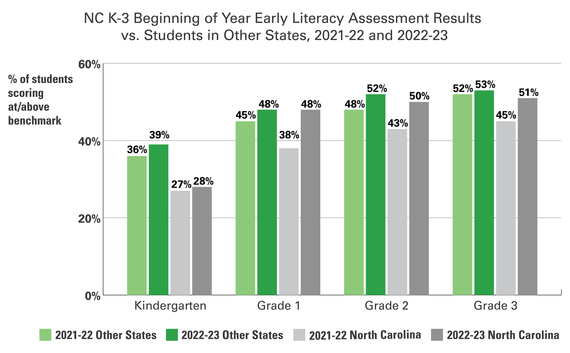|
Students in early elementary grades in North Carolina public schools continue to show gains in literacy skills, according to results of a key assessment administered at the beginning of the current school year.
The percentage of students on track in each grade, kindergarten through third, who were performing at or above the benchmark score at the beginning of the year was higher this school year than in 2021-22, reflecting gains students achieved during the previous grade level and year. Of the 454,000 North Carolina students who were assessed at the start of this school year, nearly 28,000 more were performing at or above benchmark this year compared to 2021-22.
Additionally, the statewide results show that fewer students this school year were well below assessment benchmarks and in need of intensive intervention.
Disaggregated results show that white, black and Hispanic student groups all began the year ahead of similar student groups in the same grades during the previous, 2021-22 school year.
The gains were achieved during the first full year of a far-reaching statewide initiative to support elementary school teachers with extensive training in instruction based on the “science of reading,” a phonics-based approach with strong evidence of effectiveness.
State education leaders are encouraged by the latest assessment outcomes, which they say indicate that schools across the state are implementing science of reading-based practices even as many teachers are still learning about the instructional approach through the two-year professional development program, Language Essentials for Teachers of Reading and Spelling, or LETRS.
State Superintendent of Public Instruction Catherine Truitt said she believes the results show that students started the current school year with stronger literacy skills because of more effective instruction that began during the 2021-22 school year and which will become more widespread during the next few years as all K-3 teachers statewide complete the LETRS training
“Even with LETRS training still a work in progress, we’re seeing significant gains,” Truitt said. “Teachers across the state are working hard to help students become proficient readers by grounding their instruction in the science of reading. They deserve to be commended for taking on this often very difficult and demanding work of learning themselves how to teach differently.”
The early literacy screener, DIBELS 8 (Dynamic Indicators of Basic Early Literacy Skills), an updated version of the previous DIBELS assessment from mCLASS , is based on the science of reading and measures students’ risk level on component skills involved in reading such as phonemic awareness and phonics. The tool was used with all kindergarten through third grade students in North Carolina for the first time in the 2021-22 school year.
The latest assessment results also showed that North Carolina students in all four grades made greater gains than students in other states using the same assessment, measuring their literacy skills at the beginning of the 2022-23 school year. Among North Carolina students in first grade, for example, where the largest gain of the four grades was measured over 2021-22 results – the percentage of students meeting the benchmark climbed from 38% to 48% in 2022-23. Among first graders in other jurisdictions nationally who took the same assessment, the percentage difference was 3 points: 45% in 2021-22 and 48% in 2022-23.
In the other three grade levels, North Carolina’s year-to-year gains also outpaced the aggregate gains of students in other districts in the nation taking the same assessment. North Carolina’s results were compared with those of 1.6 million K-3 students elsewhere in the nation whose literacy skills are measured with the same assessment, according to Amplify, the education company that provides the mCLASS assessment under contract with the Department of Public Instruction.
 Amplify reported significant increases in percentages of North Carolina students in grades 1-3 at or above benchmarks on beginning-of-year mCLASS assessments in 2022-23 compared to 2021-22. In all three grades, the gains were greater than a data set representing students in all states except North Carolina.
The updated assessment that North Carolina schools used during the 2021-22 school year more closely matches the science of reading’s emphasis on five critical components: phonemic awareness, phonics, fluency, vocabulary, and comprehension. Consequently, comparisons from last year’s results to past years are not compatible.
Additionally, the assessment results are not comparable to the state’s end-of-grade reading tests, which are administered beginning in the third grade. Those exams measure whether a student has mastered grade-level standards, from a basic level to more rigorous comprehension, while the mCLASS assessment measures the essential, foundational skills that students need to become successful readers.
Beginning-of-year assessments in first and second grades also are not comparable to the previous grade level’s end-of year assessments because the measures assessed change from grade level to grade level, which affect the composite score. As a result, the percentage of students assessed as being on track at the end of the previous grade level may be higher than the percentage of students measured as being on track at the beginning of the next grade level.
Teachers administer the mCLASS assessment with students individually at the beginning, middle and end of the school year, and are encouraged to use it between established benchmarks to monitor student progress. In addition to student progress monitoring data, the various component skills measured by mCLASS also help guide teachers in their literacy instruction and interventions.
Amy Rhyne, who leads the state’s early literacy program as director of the Office of Early Learning at the Department of Public Instruction, said she believes the latest assessment results reflect a significant effort by teachers statewide to improve literacy skills for all students.
“We are extremely proud of the shifts teachers are already making as they intentionally align instruction to what they are learning about the science of reading,” Rhyne said. “Early data also indicate better results in schools where teachers are progress monitoring with fidelity, between benchmarks. Responding to data in a timely manner allows for ongoing, aligned instructional supports.”
|